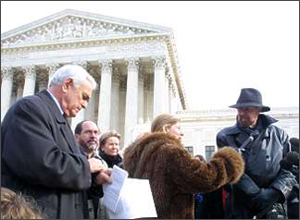
Scheidler takes reporters’ questions on the Court steps after the hearing [Photo by Martin Lueders]
“All rise! The Honorable the Associate Justices of the Supreme Court of the United States!” The eight Associate Justices file into the hushed courtroom and take their seats before a curtain of red velvet as the Marshal intones “Oyez!” three times, meaning “Hear ye!” A scene above the Justices depicts Moses presenting the Ten Commandments. “All persons having business before the Honorable the Supreme Court of the United States are admonished to draw near and give their attention, for the Court is now sitting!” continues the Marshal. “God save the United States and this Honorable Court!”
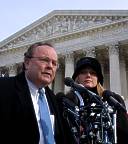
Lead attorney Thomas Brejcha with assistant attorney Debby Fischer [Photo by Martin Lueders]
With the clap of a gavel, the latest and possibly final chapter of the sixteen-year-old NOW v. Scheidler case begins. Defendants Joe Scheidler, Tim Murphy and Andrew Scholberg take their seats as the Court prepares to hear the appeal of their 1998 Federal District Court conviction on racketeering charges.
Court Hears Oral Arguments
On Wednesday, December 4, the eight Associate Justices of the Supreme Court heard oral arguments in the NOW v. Scheidler case (Chief Justice William Rehnquist was out with an injury). The Court is considering two issues in this appeal: (1) whether peacefully blocking an abortion clinic entrance or delaying a woman’s access to a clinic constitutes the federal crime of “extortion,” and (2) whether private parties like NOW and the clinics can sue under RICO for the devastating penalty of a federal injunction against the “racketeers.”
Prior to the Supreme Court appearance, lead attorney Tom Brejcha of the Thomas More Society Pro-Life Law Center selected Washington attorney Roy Englert to present the oral arguments, considering Englert’s dozen victories before the High Court. Building on his partner Alan Untereiner’s extensive work on the case—which was key to convincing the High Court to hear the appeal—Englert presented strong arguments against the federal injunction and extortion charges.
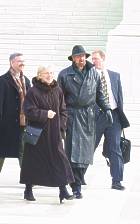
Scheidlers leave court with son Joe (right) and Ann’s brother Pat (left)
[Photo by Martin Lueders]
Solicitor General Ted Olson, of Gore v. Bush fame, represented the federal government, and argued that extortion charges could apply to abortion clinic blockades, but agreed with Englert that the injunction should be thrown out. NOW attorney Fay Clayton attempted to defend both elements of the lower court’s judgment.
Roy Englert for the Defense
It was clear from the start that the Justices had thoroughly prepared for the hearing and knew precisely what issues were at stake. Only minutes into his presentation on why the extortion charges should be overturned, Englert was interrupted by questions from Justices John Paul Stevens and Antonin Scalia on why the abortion protesters did not “obtain” the property of clinic owners by temporarily stopping abortions. Justices Anthony Kennedy and Steven Breyer seemed concerned about the impact such a notion of “obtaining” property would have on nonviolent protest.
Englert went on to present the case against NOW’s injunction, showing that Congress never intended private parties to have access to such a powerful weapon, and that the language of the RICO statute does not support it.
Olson and the First Amendment
The mainstream media widely reported that Solicitor General Ted Olson argued against Scheidler and the other defendants, but that is not entirely accurate. Rather, Olson defended only the extortion charges, and only as they applied to the clinic owners, whose business was disrupted by the abortion protests.
Justice Kennedy: “There’s always a First Amendment implication in a protest case.”
Early in his remarks Olson stated that the First Amendment is not an issue in this case. Justice Kennedy interrupted him. “There’s always a First Amendment implication in a protest case,” he said. “There is a First Amendment issue in the case because of the broad definition you’re proposing.”
Justice Scalia suggested that the broad definition of “obtaining property” in the lower court judgment would constantly require the Court “to sort out whether that definition doesn’t sail too close to the wind with respect to First Amendment rights.”
Kennedy’s and Scalia’s comments were encouraging to the defense. In accepting Scheidler’s appeal, the Court specifically refused to directly consider the First Amendment issue. Nevertheless, Untereiner was certain the First Amendment would have to come in anyway—clearly he was right.
Olson Concedes Need for Remand, Maybe New Trial
Justice Sandra Day O’Connor suggested to Olson that even if clinic owners could claim extortion, women seeking abortions couldn’t. “If we agreed with your view—and I’m not sure we will—about property including the right to control business assets . . . could the jury verdict be upheld here?”
O’Connor: “Is your bottom line a new trial?”
Olson: “That might have to be the result.”
Olson replied, “I think that it would have to be sent back to the Seventh Circuit for a remand to examine that question.” A remand would send the case back to the Circuit Court for clarification.
The jury was never instructed to distinguish between “extortion” of clinic owners’ right to conduct the business of abortion and “extortion” of women’s “property right” to receive abortion services. There is no way to know which species of “extortion” the jury had in mind.
O’Connor remarked that “we have no idea what the jury went on,” and asked Olson, “Is your bottom line a new trial? Because the charge doesn’t match the theory you’re putting forward.”
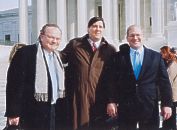
Attorneys Tom Brejcha, Alan Untereiner and Roy Englert
[Photo by Wendy Wright]
Olson answered, “I think . . . that might have to be the result.”
Olson argued against the injunction, backing Englert’s argument that the RICO statute does not allow private parties to receive injunctive relief, as the Court has consistently held.
Fay Clayton Out of Her Depth
NOW’s position was already weakened by the Justices’ exchanges with Engler and Olson before Fay Clayton began her defense of the lower court ruling.
Clayton’s argument in favor of the injunction didn’t seem to impress the Justices. She claimed that the language of the RICO statute doesn’t restrict private parties like NOW from seeking injunctive relief. In concert, Justices Scalia and Breyer asked, “What else could it mean?” suggesting they thought the statute clearly allows only the Government to seek an injunction.
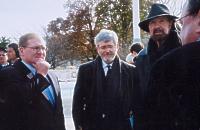
(From left) Attorney Roy Englert, Tim Murphy, Joe Scheidler and Attorney Tom Brejcha confer after the oral arguments
[Photo by Wendy Wright]
Justice Ruth Bader Ginsburg seemed unconvinced by Clayton’s argument that women have some kind of “property right” to abortion services which was “extorted” from them, and suggested that NOW’s own brief seemed to concede that. This echoed Justice O’Connor’s earlier remarks to Ted Olson.
Scalia Interrogates Clayton
Justice Breyer expressed concern that extortion charges could be brought against protests like the lunch counter sit-ins of the civil rights movement. Clayton responded, “Martin Luther King didn’t tell his followers to go into the Woolworth’s and bash people around.”
Justice Scalia interjected, “You’ve used the term ‘violence’ several times. That’s not what the instruction required. As your argument to the jury itself indicated, it was enough if they obstructed the entrance and ‘failed to part like the Red Sea’ if somebody wanted to go in.”
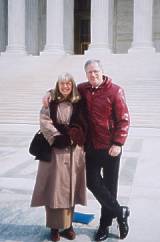
California Attorneys Colette Wilson and Ed Gaffney wrote key court briefs
[Photo by Wendy Wright]
“Not true,” Clayton insisted.
Scalia then read aloud Clayton’s own words from the trial transcript. She had told the jury that the defendants would be guilty of an extortionate act unless they were to “part like the Red Sea, and let a woman through” to the abortion clinic. “In other words,” said Scalia, “you told the jury that you could find an offense . . . by the mere blockade. It wasn’t smacking people around. It was just not letting people in.”
“No, your honor,” Clayton insisted.
“So,” said Scalia, “you’re changing your position here.”
“No, your honor.”
“I see,” said Scalia skeptically.
The hearing ended with a rebuttal by Roy Englert.
Scheidler Cautiously Optimistic
The Justices seemed unwilling to accept the notion that “extortion” is involved when a woman is temporarily prevented from getting an abortion. NOW’s case depended largely on highly emotional testimony from women who claimed to feel threatened when approaching clinics. If only clinic owners can claim extortion of their property rights, much of NOW’s case goes out the window. Several Justices seemed reluctant to accept even the clinic owners’ extortion claims.
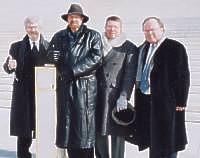
“Racketeers” (from left) Tim Murphy, Joe Scheidler and Andy Scholberg with Tom Brejcha
[Photo by Wendy Wright]
The federal injunction also came under close scrutiny, especially since a 1994 Freedom of Access to Clinics (FACE) law makes it redundant. But upholding the injunction could impact other protest groups, as attested to by the nearly seventy groups and individuals that submitted amicus briefs supporting Scheidler’s appeal.
Until a decision is handed down next year we remain cautiously optimistic. Though it seems unlikely, the court could decide in NOW’s favor, upholding the extortion charges and the monetary damages that go with them, as well as the federal injunction. They could also reverse the jury verdict in toto, handing the pro-life side an outright victory.
It is also possible that the court could remand the case to the Appelette Court or send it all the way back to District Court for a retrial. This would still be a victory for the pro-life side. NOW would return to the lower court with a far weaker case than it had in 1998.
A decision is expected by June.
Links and Related Articles
- U. S. Supreme Court to Review NOW v Scheidler (Article from August 2002 Action News).
- NOW v Scheidler main page on this website.
- Jonathan Turley article on NOW v Scheidler compares NOW to Captain Ahab—and Joe Scheidler to Mody Dick! Addresses free speech implications of the case.
- Catholic New World (Chicago Archdiocese) article from 12/8/02 on NOW v Scheidler.
- NOW’s take on the Supreme Court oral arguments
